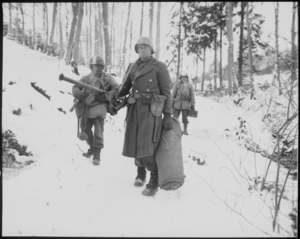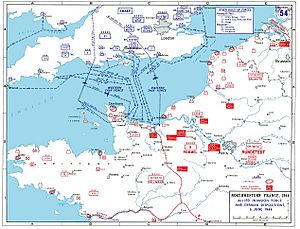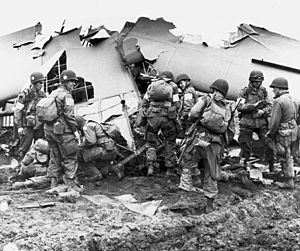Jack Womer facts for kids
Quick facts for kids
Jack Womer
|
|
|---|---|
| Nickname(s) | "Hawk Eye" |
| Born | June 18, 1917 Lewistown, Pennsylvania, U.S. |
| Died | December 28, 2013 (aged 96) Dundalk, Maryland, U.S. |
| Allegiance | |
| Service/ |
|
| Years of service | 1941–1945 |
| Rank | Sergeant |
| Unit | 29th Ranger Battalion 101st Airborne Division 506th Parachute Infantry Regiment |
| Battles/wars | Second World War Normandy Invasion (Operation Overlord) Operation Market-Garden Battle of the Bulge |
| Awards | Bastogne Medal Honorable Service Lapel button Sharpshooter Badge |
| National Order of the Legion of Honour | |
|---|---|

Knight medal of the French Légion d'honneur
|
Jack Neitz Womer (June 18, 1917 – December 28, 2013) was a brave American soldier. He fought in World War II and was a famous member of a special group called the Filthy Thirteen.
Womer was part of several important military units. These included the 29th Ranger Battalion, the 101st Airborne Division, and the 506th Parachute Infantry Regiment (506th PIR). He was known for being very smart in battle. He said this was thanks to his tough training with British Commandos. Because of his skills, Womer was never hurt in combat.
Jack Womer was one of the "Filthy Thirteen" who parachuted into Normandy, France, on June 6, 1944. This was a huge event called the Normandy Invasion. He was the only member of the original "Filthy Thirteen" to fight in many major battles. These included Operation Market-Garden in September 1944 and the Battle of the Bulge in December 1944. He also advanced on Adolf Hitler's home in Germany in 1945.
When he passed away on December 28, 2013, Womer was the last living member of the original "Filthy Thirteen." In 2012, a book about his life was published. It was called Fighting With the Filthy Thirteen: The World War II Story of Jack Womer: Ranger and Paratrooper.
Contents
Jack Womer's Early Life
Jack Womer was born on June 18, 1917, in Lewistown, Pennsylvania. He was the fourth child in his family. When he was a baby, his mother became sick. Jack went to live with his aunt in Sunbury, Pennsylvania.
In 1922, his family moved to Sparrows Point, Maryland. Later, in 1930, they moved to a bigger house in Dundalk, Maryland. Jack went to both public and private schools. He was very good at sports and even got a scholarship for it.
In 1936, Jack started working at Bethlehem Steel. He worked there for over 40 years, except for the time he spent serving in the military during World War II. He retired in 1982.
Jack married Theresa Cook in November 1945. They had two children, a son named John and a daughter named Ellen. Theresa passed away in 1987. Jack Womer died at the age of 96 on December 28, 2013.
Jack Womer's Military Service
Jack Womer joined the U.S. Army on April 25, 1941. He was first assigned to the 175th Infantry Regiment. He trained with the 29th Infantry Division in Maryland.
In late 1942, Womer and his division were sent to Europe. They traveled by ship to England. There, they continued their training at an old military camp.
Joining the Rangers
In late 1942, a new special unit was being formed: the 29th Provisional Ranger Battalion. Soldiers had to be very strong and brave to join. Womer volunteered and passed the tough tests.
From December 1942 to January 1943, the Ranger volunteers trained in England. Then, they went to Scotland for five weeks of intense training. They were taught by experienced British Commando instructors.
Womer said this training was the hardest he ever did. But he believed it taught him how to think smartly in battle. He felt it saved his life and the lives of others.
In September 1943, Womer helped train new Ranger recruits. He worked with British Commando units on landing assaults. In October 1943, the 29th Provisional Ranger Battalion was disbanded. Womer returned to his old unit.
The 101st Airborne and the Filthy Thirteen

After returning to his unit, Womer wanted to join another elite group. He volunteered to become a paratrooper with the 101st Airborne Division. He joined the Demolitions Platoon. This group was responsible for destroying enemy targets.
The Demolitions Platoon had a section known as the "Filthy Thirteen." This group got its nickname because they often didn't shave or clean their uniforms. They were known for their daring missions.
Jake McNiece, a sergeant in the "Filthy Thirteen," heard about Womer's Commando training. Impressed, McNiece asked for Womer to join his section.
With the "Filthy Thirteen," Womer fought in the Normandy Invasion. He also took part in Operation Market-Garden and the Battle of the Bulge. Womer used his Commando training a lot during these battles. He believed it helped him and many other soldiers survive.
After Jake McNiece left in December 1944, Womer was promoted to sergeant. He led the "Filthy Thirteen" until the end of the war. Jack Womer was the only member of the "Filthy Thirteen" to fight in all these major battles. He even advanced on Adolf Hitler’s home in Germany.
After World War II
Jack Womer left the military in September 1945. He went back home to Dundalk and returned to his job at Bethlehem Steel. In November 1945, he married Theresa Cook. He retired in 1982 after working for over forty years.
In 2003, a friend named Stephen C. DeVito contacted Womer. DeVito had found an old photo of Womer training as a Ranger. They became good friends and wrote Womer's biography together. The book, Fighting with the Filthy Thirteen, was published in 2012.
Awards and Recognitions
Jack Womer received many medals and honors for his service. In 2012, people in France asked their government to give him the French Legion of Honor. This is the highest award given by the French government.
Womer received the medal in June 2013 during a special ceremony in France.
Here are some of the awards he received:
- The Legion of Honor
- The Honorable Service Lapel button
- The Sharpshooter Badge
- The Bronze Star
- Bastogne Medal



